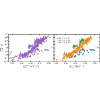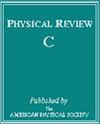α decay law of excited nuclei and its role in stellar decay rates
IF 3.4
2区 物理与天体物理
Q1 Physics and Astronomy
引用次数: 0
Abstract
decay is one of the prominent decay modes in the nucleosynthesis of heavy and superheavy elements synthesized at temperatures of the order of gigakelvin. To facilitate the investigation of the role played by the decay half-lives of thermally excited nuclei in nucleosynthesis calculations, an empirical formula based on a model for the decay of nuclei in their ground and excited states to daughter nuclei in their ground or excited states is presented. Constants appearing in the analytical expression for the decay half-life obtained within the model are treated as adjustable parameters and fitted to experimental data on 342 decays in the range of 82 94, to obtain an excitation energy-dependent decay law. Under the assumption that thermal equilibrium has been reached between nuclear states, temperature () dependent half-lives, , for several of the experimentally studied emitters with 65 94 are presented using available data on the half-lives of excited nuclei. Though the general trend is a decrease in at elevated temperatures, exceptional cases with increased half-lives are found in the case of some isomeric states. A list of such isomers provided in this paper motivates future work involving considerations of their thermal equilibration and role in shaping kilonova light curves.

激发核的α衰变规律及其在恒星衰变率中的作用
α衰变是在千兆开尔文温度下合成重元素和超重元素的核合成过程中的主要衰变模式之一。为了便于研究热激发核的α衰变半衰期在核合成计算中所起的作用,本文提出了一个基于原子核在基态和激发态下向基态或激发态子核的α衰变模型的经验公式。模型中得到的 α 衰变半衰期分析表达式中出现的常数被视为可调参数,并与在 82 ≤Zp≤94 范围内的 342 个 α 衰变的实验数据进行拟合,从而得到一个与激发能量有关的衰变规律。在假设核态之间已经达到热平衡的前提下,利用现有的激发核半衰期数据,介绍了实验研究的 65 ≤Zp≤94 的几种α发射体的与温度(T)相关的半衰期 t1/2(T)。虽然总的趋势是温度升高时 t1/2(T)减小,但在某些异构态中发现了半衰期延长的特殊情况。本文提供了一份此类异构体的清单,这促使我们在今后的工作中考虑它们的热平衡以及在形成千新星光变曲线中的作用。
本文章由计算机程序翻译,如有差异,请以英文原文为准。
求助全文
约1分钟内获得全文
求助全文
来源期刊

Physical Review C
物理-物理:核物理
CiteScore
5.70
自引率
35.50%
发文量
0
审稿时长
1-2 weeks
期刊介绍:
Physical Review C (PRC) is a leading journal in theoretical and experimental nuclear physics, publishing more than two-thirds of the research literature in the field.
PRC covers experimental and theoretical results in all aspects of nuclear physics, including:
Nucleon-nucleon interaction, few-body systems
Nuclear structure
Nuclear reactions
Relativistic nuclear collisions
Hadronic physics and QCD
Electroweak interaction, symmetries
Nuclear astrophysics
 求助内容:
求助内容: 应助结果提醒方式:
应助结果提醒方式:


